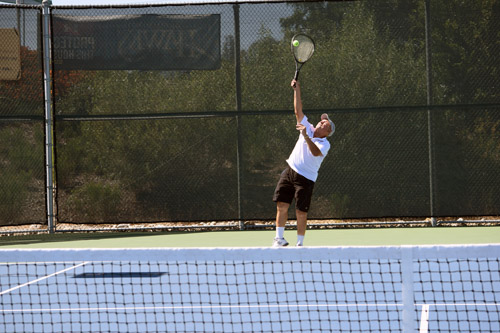
–23rd in a Series–
Exit 9, Waring Road, San Diego ~ Lake Murray Tennis Club
By Donald H. Harrison
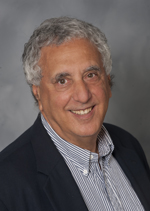
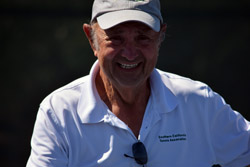
SAN DIEGO—Soft-spoken, easy-going Saul Snyder is easy to underestimate. An opponent once told him, “you look like my accountant,” but that was before he faced Snyder across the tennis net, and lost. He learned, as many others had before and since, that Snyder, who is an octogenarian, is one of the finest tennis players in the world.
No, that’s not hyperbole; Snyder has rooms filled with plaques, awards and “golden balls” attesting to his prowess on the tennis court—whether the surface be hard, clay or grass. In 2008, he was the United States Tennis Association’s (USTA) singles champion for men 75 and over in both hard court and clay court play. In 2012 he was the Southern California Tennis Association’s Senior Player of the Year, as well as USTA’s 2012 doubles winner in clay court competition in Virginia Beach.
He won the gold medal at Israel’s 14th Maccabiah games in 1993, and 20 years later in Croatia, he and Joyce Jones won the gold medal for mixed doubles play for people over 80 – a world championship!
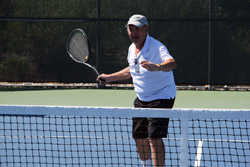
Although he hasn’t won a grass court championship—there are few such courts in Southern California on which to practice—Snyder says that he really likes the feel of them, and how “you can expect everything to be below your knees when it is coming at you.” He reached the quarter finals in one grass court tournament, along the way beating a fellow who was seeded No. 1.
Snyder is based at the 10- hard-court Lake Murray Tennis Club at 7003 Murray Park Drive near the junction of the San Carlos and Del Cerro neighborhoods of San Diego. The city-owned facility overlooks a San Diego reservoir that is part of the sprawling Mission Trails Regional Park. Snyder lives approximately three blocks from the courts, and he likes to joke that now that he’s “retired,” his biggest decision is whether to walk or drive to a match.
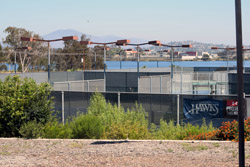
He’s not exactly “retired” because as a former real estate broker, he listened to his own sales pitches about how valuable apartment house properties are, and now he and his wife Sonia own apartment complexes in San Diego; Riverside, California; and Houston, Texas. Although a management company looks after the properties, he says he likes to do a little work around them now and then—mainly pulling up weeds and picking up papers. Playing tennis prepares him well for such tasks, he acknowledges; he often has to pick up balls from the surface of the courts.
Danielle Bryan, one of the tennis teachers at the club which has been managed since 2000 by her parents Dan and Kathy Emmerson, says that the strength of Snyder’s game is that he is fast – he can reach most balls that other people would let go – and that he excels at shot placement.
Asked if he agreed with that assessment, Snyder said he was fortunate to have developed good speed and stamina, as well as a drop shot that has opponents rushing to the net to return, and which he follows with a lob shot over their heads. His serves don’t smoke by any means, but they go where he wants them to – often in the opposite direction from where his opponent think he’s looking.
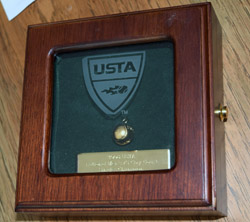
I asked if as one whose 83rd birthday is in September he has a special diet or physical regimen to keep himself fit. He responded that he makes certain to eat light meals more than two hours before a match, so that he has time to digest them, and that he always, but always, engages in stretching exercises before he plays. Opponents whose meals are too heavy, he noted, tend to feel sluggish and by the time the match gets around to the third set, they can be too tired for vigorous competition. Generally speaking, he likes to follow a “Mediterranean diet: salads, fruit, fish, chicken, very little beef, no pork. I also stay away from trans fats, watch my cholesterol, and I stretch, exercise.”
He also said that he tries to remain relaxed and jovial up until he gets on the court, but as soon as it’s time for the first serve of the match, he concentrates fully on his game. In fact, he gives full attention to his opponent in the warm-up period prior to the match, in an effort to determine whether that person has a weak forehand or backhand, or is out of shape. “I will play against those weaknesses,” he readily concedes. “They do the same thing to me.”
En route to any match, Sonia reminds him to “focus, focus, focus!”
Is that because he gets distracted? I asked
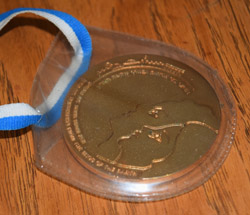
Snyder responded that most of the time, he has no difficulty concentrating, except when members of his family are in the stands watching, or there has been distressing family news such as someone’s sickness or marital problems.
What’s the problem with members of his family being in the stands? Sometimes, instead of watching, he said, “they’re reading books.”
That will knock down any tennis player’s ego.
Snyder began playing tennis shortly after World War II while a student at Beverly Hills High School. At that point, he was far from the phenomenon he is today. In fact he was tenth on the school’s tennis ladder, meaning he sat on the bench when the Normans played other high school teams. The top five players were the ones that usually got to compete.
Later at UCLA, he continued to play, but more for fun rather than for school competitions. However, one contest against a fellow Beverly Hills High School alumnus he considered to be a grudge match. The fellow had won an award for sportsmanship even though “on the court he was not a good sport, and I resented it. Even though at the time, I was overweight, I struggled through three sets and I beat him.”
Until he was about 60, he played recreational tennis, just having fun, and never thought about entering tournaments until some friends told him, “you are really better than you think you are” and “you should get better equipment.” He traded in his wooden racket for an aluminum one and joined the San Carlos Tennis Club, which closed after a year so that the landowners could develop condominiums.
At that point, San Diego City Councilwoman Judy McCarty, sensitized to the needs of the tennis community by a daughter who was taking tennis lessons, came to the rescue, winning funding for construction of the Lake Murray Tennis Club, where membership is open to all. Initially eight courts were built, but the citizen board that runs the club decided to raise the money to construct two more.
Snyder served one year as president of the Lake Murray Tennis Club’s Board of Directors, drawing perhaps on his experience as a vice president for membership for Congregation Beth Tefilah, a Conservative synagogue that since merged with Adat Ami Synagogue to form Ohr Shalom Synagogue.
Meetings of the relatively few board members of the Lake Murray Tennis Club were held in the clubhouse with a few chairs being drawn up near the sofas. Some of the issues Snyder remembers from his term were whether women’s teams could import players from other clubs (no!) and whether to build those new courts. Other issues were relatively minor, he recalled.
A plaque inside the clubhouse tells of the United States Tennis Association rating it as an “outstanding facility” in 2001. What makes the place so special? I asked.
“I think it’s the friendliness of the players, that we have a clubhouse that doubles as a meeting place,” he responded. “It has two bathrooms (with a shower), a pro shop, where you can get stringing, and purchase rackets and shoes. Kathy and Dan Emmerson are outstanding managers of the club.”
Occasionally some young elementary school-age relatives will ask Snyder for some pointers about tennis, and he likes to quote from a book by Ed Collins, who is an instructor at the Peninsula Tennis Club in Ocean Beach. “Watch the ball, bend your knees. That will be $20 please.”
Of all the trophies, medals, and gold balls he has received, Snyder seems to hold one in which he was named “Sportsman of the Year” by the San Diego district tennis association in highest esteem.
“Most of the matches we are in, we call our own lines,” Snyder related. “If you are not a sportsman and you are looking only to win and you are willing to cheat, there are opportunities to do that, but you would become quickly known for that quality. I think sportsmanship is quite important.”
Unfortunately not everyone in tennis acts so honorably. “I have played against cheaters,” Snyder said. “One time in Rancho Mirage I was beaten in a close match, and about an hour later a stranger came up to me, and said he had watched the match and that “several of the balls you hit were called out but weren’t.”
In a doubles match, he recalled, he and his partner were in a tie break game against a twosome whom they had never beaten. “They hit some balls that were pretty close. When it is near your feet and deep, it is hard to call, and I called their balls ‘fair!’ and we lost.” When the game was over, one of the opponents told him, “Saul there is one more thing that you need in your armament – line calls,” meaning that I should have called some out that were out.”
In another match, he was playing a fellow “who hits the ball as hard as you will ever see, and following that game I was to play a mixed doubles game with Roz King. Roz was watching the singles match against this fellow, which he won. She came storming on the court and said ‘don’t you ever do that when you are playing with me! You gave him 4-5 points.’ He hit the ball so hard, I had to turn my head to see where it landed, and if it is close , I can’t call it out.”
Given the choice between winning a championship, and being an honest and sportsman-like competitor, Snyder said there is no question that he would choose the latter.
“When this game stops being fun,” he declared, “that’s when I’m going to hang my racket up!”
In the meantime, he says, tennis provides him plenty of exercise and the chance to socialize, while keeping the mind active — an important ingredient for warding off dementia. “Tennis is played worldwide and affords a person an opportunity to meet people from all over the world and all walks of life,” Snyder said.
From Interstate 8 take the Waring Road exit (it only goes in one direction) to a left turn on Navajo Road. Turn right on Park Ridge Boulevard and follow it to the end. Entrance is just beyond the intersection with Murray Park Drive.
*
Harrison is editor of San Diego Jewish World. You may comment to him at donald.harrison@sdjewishworld.com, or post your comment on this website provided that the rules below are observed.
__________________________________________________________________
Your comment should be followed with this information: Your full name, your city and state (or country) of residence. Letters lacking such information will be automatically deleted. San Diego Jewish World is intended as a forum for the entire Jewish community, whatever your political leanings. Letters may be posted below provided they are responsive to the article to which they are affixed, and civil in their tone. Ad hominem attacks against any religion, country, gender, race, sexual orientation, or physical disability will not be considered for publication. There is a limit of one letter per writer on any given day.
__________________________________________________________________
Pingback: Disability Tennis Usa | fanatic - tennis fans
Pingback: Beverly Club Hills Tennis | players - tennis facts
Pingback: Tennis Lob Definition | information - top tennis stars